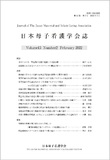Japanese
English
- 有料閲覧
- Abstract 文献概要
- 参考文献 Reference
抄録
【目的】出産時に芦屋小野式腹式呼吸法を実施した産婦の出産に関する主観的体験を記述した内容を分析し、産婦にとっての意味づけを明らかにする。
【対象者と方法】関西地域にあるAクリニックで2017年3月〜2018年1月の間に芦屋小野式腹式呼吸法による出産を体験した(帝王切開分娩を除く)産婦197名に、退院時に分娩時の呼吸法とお産に関しての体験について自由記述を依頼し、協力の得られた71名の記述を分析対象とした。質的記述的に文脈から読み取りコードとし、コードの類似性、異質性に着目しながらサブカテゴリー、カテゴリーへと集約するとともに、テキストマイニングデータとして、主観的体験の因子構造を明らかにした。
【結果】対象者は初産婦27名と経産婦44名であり、年齢と分娩所要時間に差がみられたが、胎児の健康指標に差は見られず、会陰裂傷無しは初産婦48%、経産婦は75%であった。質的記述的分析により産婦の主観的な体験として、初産婦は7カテゴリー、13サブカテゴリー、52コード抽出され、経産婦は8カテゴリー、19サブカテゴリー、74コードが抽出された。一方、テキストマイニングデータとしてのレコードから因子分析を実施したところ、両者での共通的な体験として【妊娠期の診察時の医師からの声かけから呼吸法を意識した】、【いきみが実際に楽であった】、【呼吸に集中することで陣痛をコントロールすることができ、いいお産ができた】、【赤ちゃんの存在を確認する経験であった】、【腹式呼吸を意識したことで産後も楽だった】の5つが抽出された。初産婦は妊娠中に理解し、出産時に周囲の声かけ等で陣痛コントロールし、経産婦は呼吸法の良さを知っており安心感と、胎児の存在感覚で陣痛コントロールすることが特徴であった。産後に楽であったことは共通していた。
【結論】芦屋小野式腹式呼吸法で出産を体験した産婦の主観的体験から意味づけとしては、出産は周囲や胎児との協働によって呼吸に集中することで陣痛をコントロールできいいお産につながることと、産後が楽である ことであった。
【Purpose】To analyze and find meaning in the subjective childbirth experience of parturient women who used the Ashiya Ono Abdominal Breathing method upon delivery.
【Method】197 parturient women who experienced childbirth with the Ashiya Ono Abdominal Breathing method at Clinic A between March 2017 and January 2018 (excluding cesarean delivery) were asked at the time of discharge to freely describe their experience of childbirth and the breathing method used for delivery, and description by 71 persons who provided cooperation was used as analysis targets. The context was qualitatively and descriptively interpreted into codes to be summarized into categories and sub-categories by focusing on similarity and heterogeneity of codes and at the same time to be categorized with the linguistic method as text mining data for principal component analysis.
【Results】Subjects included 27 primiparas and 44 multiparas. Their ages and time required for delivery varied; however, no difference was observed in the health index of the fetuses. No perineal laceration was observed in 48% of the primigravid women and 75% of the parous women.
As a result of qualitative and descriptive extraction, seven categories, 13 sub-categories and 52 codes were extracted for primigravid women, and eight categories, 19 sub-categories and 74 codes were extracted for parous women. When factor analysis on all descriptions was performed with records as IBM text mining data by using the linguistic method, common experiences of both primigravid and parous women were summarized into five: [I was able to deliver a child by focusing on breathing without suffering from labor pain], [I received energy from the experience to confirm the existence of my baby], [this was possible because I listened to someone talking to me and also because of the preparation during pregnancy], [it was a really easy delivery] and [postpartum was comfortable with no wounds or muscle ache]. Regarding the difference between primigravid and parous women, primigravid women raised cooperative experience with the surroundings while parous women raised cooperative experience with babies. Others were common to both of them.
【Conclusion】Meaning for parturient women who experienced childbirth with the Ashiya Ono Abdominal Breathing method is that their childbirth was successful through cooperation with the surroundings and babies by focusing on breathing without suffering from labor pain and that their post-delivery was also easy.
Copyright © 2022, The Japan Maternal and Infant Caring Association All rights reserved.


